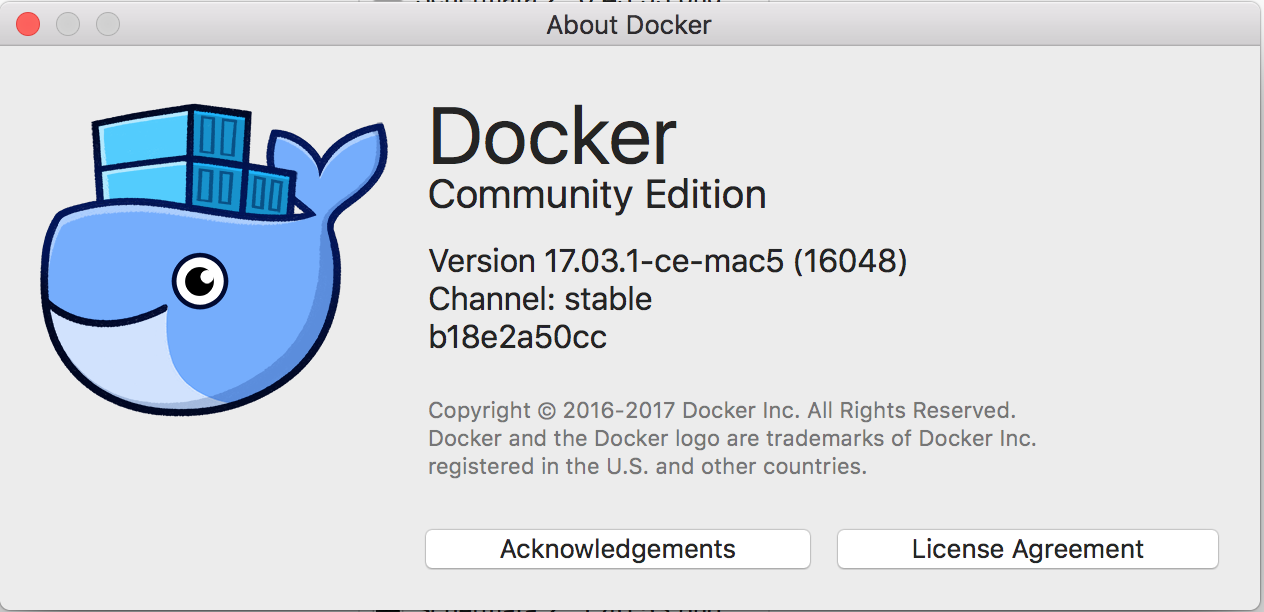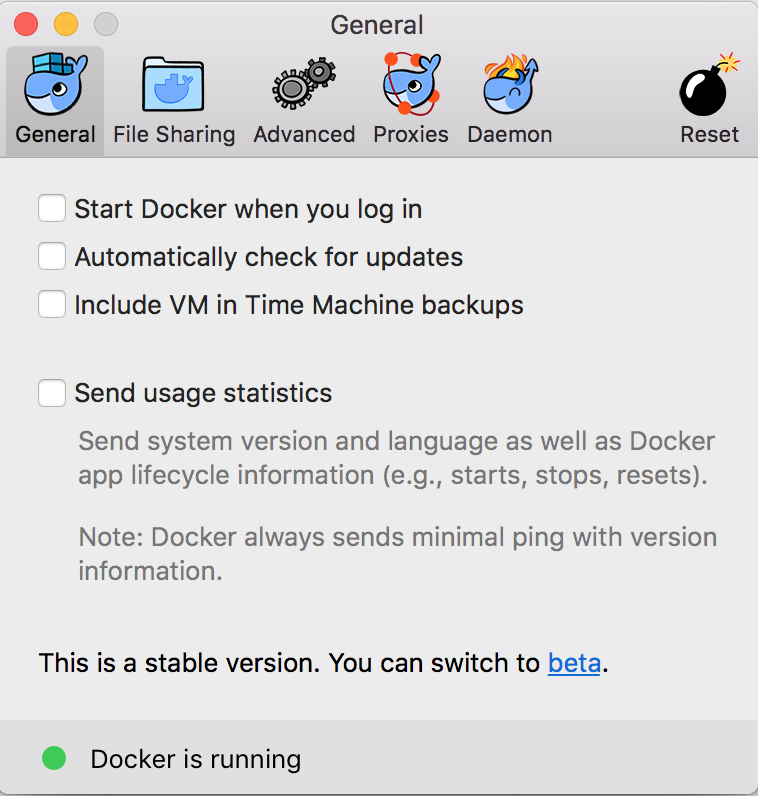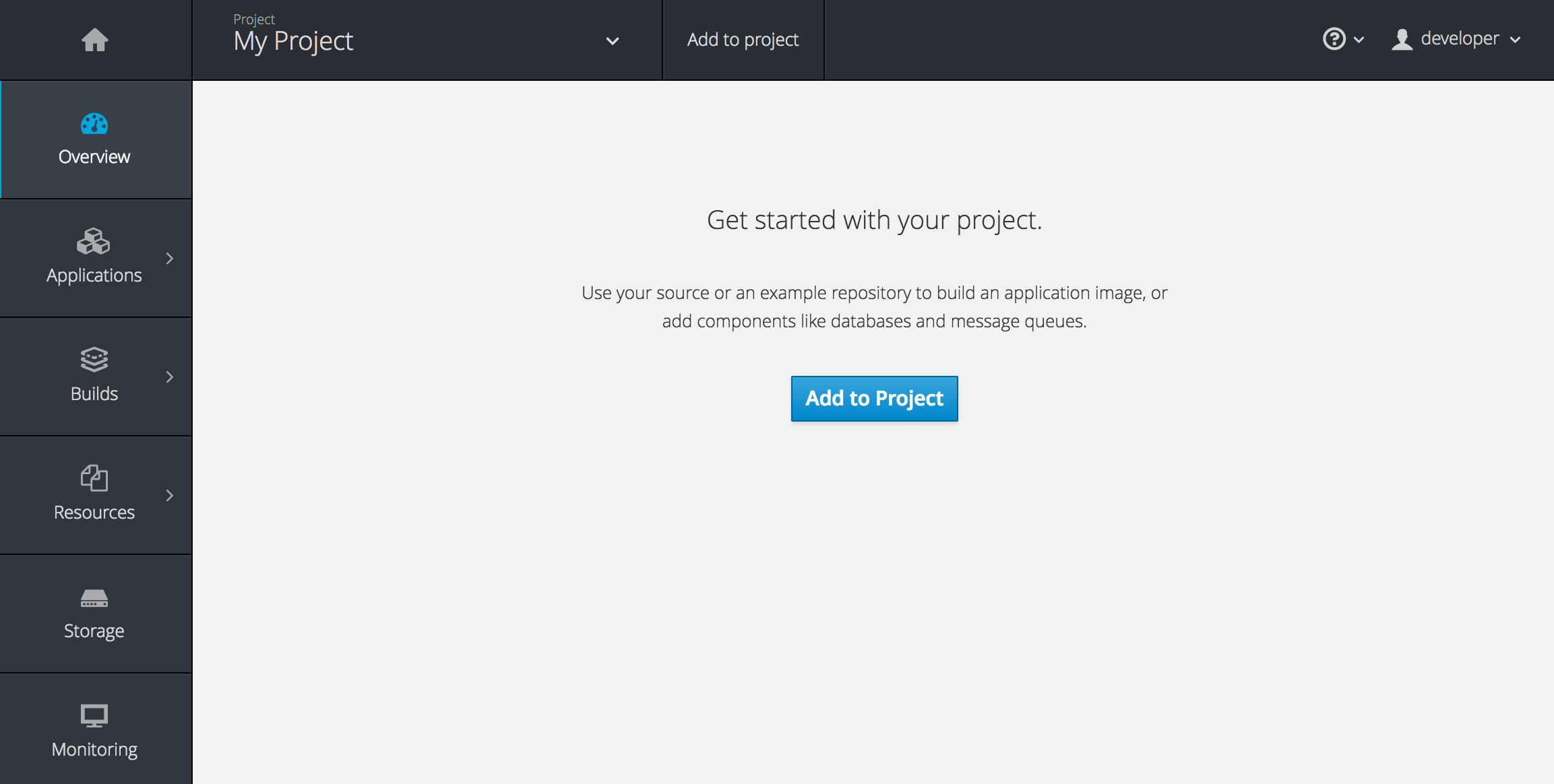openshift-kafka - fork
Run Apache Kafka and Apache ZooKeeper on OpenShift v3.
Project maintained by rondinif Hosted on GitHub Pages — Theme by mattgraham
Quick Start Explained ( part 1 of 4)
some intro notes to the platform: openshift-orign, docker and kubernetes
pre-requisites ( my environment )
docker
Get started with Docker for Mac


$ docker --version
Docker version 17.03.1-ce, build c6d412e
openshift origin
$ oc version
oc v1.5.0+031cbe4
kubernetes v1.5.2+43a9be4
features: Basic-Auth
Server https://127.0.0.1:8443
openshift v1.5.0+031cbe4
kubernetes v1.5.2+43a9be4
$ oc status
The connection to the server 127.0.0.1:8443 was refused - did you specify the right host or port?
$ oc cluster up
-- Checking OpenShift client ... OK
-- Checking Docker client ... OK
-- Checking Docker version ...
WARNING: Cannot verify Docker version
-- Checking for existing OpenShift container ... OK
-- Checking for openshift/origin:v1.5.0 image ... OK
-- Checking Docker daemon configuration ... OK
-- Checking for available ports ... OK
-- Checking type of volume mount ...
Using Docker shared volumes for OpenShift volumes
-- Creating host directories ... OK
-- Finding server IP ...
Using 127.0.0.1 as the server IP
-- Starting OpenShift container ...
Creating initial OpenShift configuration
Starting OpenShift using container 'origin'
Waiting for API server to start listening
OpenShift server started
-- Adding default OAuthClient redirect URIs ... OK
-- Installing registry ... OK
-- Installing router ... OK
-- Importing image streams ... OK
-- Importing templates ... OK
-- Login to server ... OK
-- Creating initial project "myproject" ... OK
-- Removing temporary directory ... OK
-- Checking container networking ... OK
-- Server Information ...
OpenShift server started.
The server is accessible via web console at:
https://127.0.0.1:8443
You are logged in as:
User: developer
Password: *********
To login as administrator:
oc login -u ********:admin
$ oc status
In project My Project (myproject) on server https://127.0.0.1:8443
You have no services, deployment configs, or build configs.
Run 'oc new-app' to create an application.
Important things to look at:
- from the output of
oc cluster up```Creating initial project “myproject” … OK`` - from the output of
oc status``In project My Project (myproject) on server https://127.0.0.1:8443```
oc cluster up has started five containers:
- docker-registry
- haproxy-router
- origin-pod
- origin-pod (services exposed on ports: 0.0.0.0:80->80/tcp, 0.0.0.0:443->443/tcp, 0.0.0.0:1936->1936/tcp)
- origin
$ docker ps
CONTAINER ID IMAGE COMMAND CREATED STATUS PORTS NAMES
67d62b0c58a7 openshift/origin-docker-registry:v1.5.0 "/bin/sh -c 'DOCKE..." 31 minutes ago Up 31 minutes k8s_registry.182cd305_docker-registry-1-96qvm_default_faadf000-7342-11e7-a3c7-22fd782a32ab_17b0eb1b
5fa409ab1c66 openshift/origin-haproxy-router:v1.5.0 "/usr/bin/openshif..." 31 minutes ago Up 31 minutes k8s_router.d0ff2a42_router-1-t2tn4_default_fa800d30-7342-11e7-a3c7-22fd782a32ab_68519235
3e2e2d39bf4a openshift/origin-pod:v1.5.0 "/pod" 31 minutes ago Up 31 minutes k8s_POD.a4a0fe84_docker-registry-1-96qvm_default_faadf000-7342-11e7-a3c7-22fd782a32ab_ee47019f
1595e962b3ff openshift/origin-pod:v1.5.0 "/pod" 31 minutes ago Up 31 minutes 0.0.0.0:80->80/tcp, 0.0.0.0:443->443/tcp, 0.0.0.0:1936->1936/tcp k8s_POD.efdd479f_router-1-t2tn4_default_fa800d30-7342-11e7-a3c7-22fd782a32ab_f23e4ecd
6d69655cf7f1 openshift/origin:v1.5.0 "/usr/bin/openshif..." 31 minutes ago Up 31 minutes origin
still no resources in origin
$ oc get all
No resources found.
confirmed in the gui openshift web console
login as: ‘developer’ and see the project My Project (myproject) still without resources defined

both in web console and the CLI you can get different types of resources:
$ oc get
You must specify the type of resource to get. Valid resource types include:
* buildconfigs (aka 'bc')
* builds
* clusters (valid only for federation apiservers)
* componentstatuses (aka 'cs')
* configmaps (aka 'cm')
* daemonsets (aka 'ds')
* deployments (aka 'deploy')
* deploymentconfigs (aka 'dc')
* endpoints (aka 'ep')
* events (aka 'ev')
* horizontalpodautoscalers (aka 'hpa')
* imagestreamimages (aka 'isimage')
* imagestreams (aka 'is')
* imagestreamtags (aka 'istag')
* ingresses (aka 'ing')
* groups
* jobs
* limitranges (aka 'limits')
* namespaces (aka 'ns')
* networkpolicies
* nodes (aka 'no')
* persistentvolumeclaims (aka 'pvc')
* persistentvolumes (aka 'pv')
* pods (aka 'po')
* podsecuritypolicies (aka 'psp')
* podtemplates
* policies
* projects
* replicasets (aka 'rs')
* replicationcontrollers (aka 'rc')
* resourcequotas (aka 'quota')
* rolebindings
* routes
* secrets
* serviceaccounts (aka 'sa')
* services (aka 'svc')
* statefulsets
* users
* storageclasses
* thirdpartyresources
error: Required resource not specified.
Use "oc explain <resource>" for a detailed description of that resource (e.g. oc explain pods).
See 'oc get -h' for help and examples.
learning about some kubernetes resource types
It’s worth learning about some kubernetes resource types we have to deal:
… or just in terminal with oc explain and oc types
oc explain
$ oc explain services
DESCRIPTION:
Service is a named abstraction of software service (for example, mysql) consisting of local port (for example 3306) that the proxy listens on, and the selector that determines which pods will answer requests sent through the proxy.
FIELDS:
spec <Object>
Spec defines the behavior of a service.
http://releases.k8s.io/HEAD/docs/devel/api-conventions.md#spec-and-status
status <Object>
Most recently observed status of the service. Populated by the system.
Read-only. More info:
http://releases.k8s.io/HEAD/docs/devel/api-conventions.md#spec-and-status
apiVersion <string>
APIVersion defines the versioned schema of this representation of an
object. Servers should convert recognized schemas to the latest internal
value, and may reject unrecognized values. More info:
http://releases.k8s.io/HEAD/docs/devel/api-conventions.md#resources
kind <string>
Kind is a string value representing the REST resource this object
represents. Servers may infer this from the endpoint the client submits
requests to. Cannot be updated. In CamelCase. More info:
http://releases.k8s.io/HEAD/docs/devel/api-conventions.md#types-kinds
metadata <Object>
Standard object s metadata. More info:
http://releases.k8s.io/HEAD/docs/devel/api-conventions.md#metadata
$ oc explain pods
DESCRIPTION:
Pod is a collection of containers that can run on a host. This resource is created by clients and scheduled onto hosts.
FIELDS:
status <Object>
Most recently observed status of the pod. This data may not be up to date.
Populated by the system. Read-only. More info:
http://releases.k8s.io/HEAD/docs/devel/api-conventions.md#spec-and-status
apiVersion <string>
APIVersion defines the versioned schema of this representation of an
object. Servers should convert recognized schemas to the latest internal
value, and may reject unrecognized values. More info:
http://releases.k8s.io/HEAD/docs/devel/api-conventions.md#resources
kind <string>
Kind is a string value representing the REST resource this object
represents. Servers may infer this from the endpoint the client submits
requests to. Cannot be updated. In CamelCase. More info:
http://releases.k8s.io/HEAD/docs/devel/api-conventions.md#types-kinds
metadata <Object>
Standard object s metadata. More info:
http://releases.k8s.io/HEAD/docs/devel/api-conventions.md#metadata
spec <Object>
Specification of the desired behavior of the pod. More info:
http://releases.k8s.io/HEAD/docs/devel/api-conventions.md#spec-and-status
oc types
$ oc types
Concepts and Types
Kubernetes and OpenShift help developers and operators build, test, and deploy applications in a containerized cloud
environment. Applications may be composed of all of the components below, although most developers will be concerned
with Services, Deployments, and Builds for delivering changes.
Concepts:
* Containers:
A definition of how to run one or more processes inside of a portable Linux
environment. Containers are started from an Image and are usually isolated
from other containers on the same machine.
* Image:
A layered Linux filesystem that contains application code, dependencies,
and any supporting operating system libraries. An image is identified by
a name that can be local to the current cluster or point to a remote Docker
registry (a storage server for images).
* Pods [pod]:
A set of one or more containers that are deployed onto a Node together and
share a unique IP and Volumes (persistent storage). Pods also define the
security and runtime policy for each container.
* Labels:
Labels are key value pairs that can be assigned to any resource in the
system for grouping and selection. Many resources use labels to identify
sets of other resources.
* Volumes:
Containers are not persistent by default - on restart their contents are
cleared. Volumes are mounted filesystems available to Pods and their
containers which may be backed by a number of host-local or network
attached storage endpoints. The simplest volume type is EmptyDir, which
is a temporary directory on a single machine. Administrators may also
allow you to request a Persistent Volume that is automatically attached
to your pods.
* Nodes [node]:
Machines set up in the cluster to run containers. Usually managed
by administrators and not by end users.
* Services [svc]:
A name representing a set of pods (or external servers) that are
accessed by other pods. The service gets an IP and a DNS name, and can be
exposed externally to the cluster via a port or a Route. It's also easy
to consume services from pods because an environment variable with the
name <SERVICE>_HOST is automatically injected into other pods.
* Routes [route]:
A route is an external DNS entry (either a top level domain or a
dynamically allocated name) that is created to point to a service so that
it can be accessed outside the cluster. The administrator may configure
one or more Routers to handle those routes, typically through an Apache
or HAProxy load balancer / proxy.
* Replication Controllers [rc]:
A replication controller maintains a specific number of pods based on a
template that match a set of labels. If pods are deleted (because the
node they run on is taken out of service) the controller creates a new
copy of that pod. A replication controller is most commonly used to
represent a single deployment of part of an application based on a
built image.
* Deployment Configuration [dc]:
Defines the template for a pod and manages deploying new images or
configuration changes whenever those change. A single deployment
configuration is usually analogous to a single micro-service. Can support
many different deployment patterns, including full restart, customizable
rolling updates, and fully custom behaviors, as well as pre- and post-
hooks. Each deployment is represented as a replication controller.
* Build Configuration [bc]:
Contains a description of how to build source code and a base image into a
new image - the primary method for delivering changes to your application.
Builds can be source based and use builder images for common languages like
Java, PHP, Ruby, or Python, or be Docker based and create builds from a
Dockerfile. Each build configuration has web-hooks and can be triggered
automatically by changes to their base images.
* Builds [build]:
Builds create a new image from source code, other images, Dockerfiles, or
binary input. A build is run inside of a container and has the same
restrictions normal pods have. A build usually results in an image pushed
to a Docker registry, but you can also choose to run a post-build test that
does not push an image.
* Image Streams and Image Stream Tags [is,istag]:
An image stream groups sets of related images under tags - analogous to a
branch in a source code repository. Each image stream may have one or
more tags (the default tag is called "latest") and those tags may point
at external Docker registries, at other tags in the same stream, or be
controlled to directly point at known images. In addition, images can be
pushed to an image stream tag directly via the integrated Docker
registry.
* Secrets [secret]:
The secret resource can hold text or binary secrets for delivery into
your pods. By default, every container is given a single secret which
contains a token for accessing the API (with limited privileges) at
/var/run/secrets/kubernetes.io/serviceaccount. You can create new
secrets and mount them in your own pods, as well as reference secrets
from builds (for connecting to remote servers) or use them to import
remote images into an image stream.
* Projects [project]:
All of the above resources (except Nodes) exist inside of a project.
Projects have a list of members and their roles, like viewer, editor,
or admin, as well as a set of security controls on the running pods, and
limits on how many resources the project can use. The names of each
resource are unique within a project. Developers may request projects
be created, but administrators control the resources allocated to
projects.
For more, see https://docs.openshift.com
Usage:
oc types [options]
Examples:
# View all projects you have access to
oc get projects
# See a list of all services in the current project
oc get svc
# Describe a deployment configuration in detail
oc describe dc mydeploymentconfig
# Show the images tagged into an image stream
oc describe is ruby-centos7
Use "oc options" for a list of global command-line options (applies to all commands).
Visual Studio Code and extensions for docker
optionals:
 useful to work on
useful to work on Dockerfile
